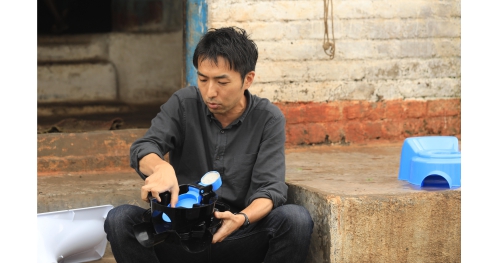Japanese building materials behemoth Lixil Group Corporation is deploying the oft overlooked ‘design’ strategy to conquer India’s bottom-of-the-pyramid market, which has been lately triggered by the Swachh Bharat Abhiyan. The company is supplying the India-specific Sato series of twin-pit Pour-Flush (TPPF) latrine that uses a V-trap to connect the Twin Pits to make switching between the two pits easier and eliminate clogging, besides requiring about 80% less water per flush. Daigo Ishiyama, director of global product design and development at Sato, speaks exclusively to SH on his design philosophy and practice, and how they are reflecting on the toilets brand.
By Mrinmoy Bhattacharjee
Is design a luxury or an essential?
Neither. Design solves problems worth solving, be it aesthetic or functional. Sato provides solutions for the very basic human sanitation needs, offered at a price point that is affordable for all.
How does your design thinking originate for a particular application?
Equal parts common sense and out of box thinking. I find beauty in simple solutions to seemingly complex problems. Some things are common everywhere – people generally want good looking, aspirational designs that make their lives safer and simpler at an affordable price. If you can make a design that does all that, you’ve got a winning product in the market. We make sure all products that carry a Sato badge satisfy these criteria.
How do cultures and nations influence your design?
The design should be based on a deep understanding of local culture. For instance, generally, people in Asia
are used to being in a squatting position, but not so much are people in Africa. That is why we created the sitting type toilets for the African market. In India, constructions of TPPF latrines are common and are being promoted under Swachh Bharat Abhiyan. Therefore, we designed technologies to suit the needs of the country.
What learning have you drawn from Sato’s use in sub-Saharan Africa and South Asia? How are you tapping in to these learnings to design Sato products for the Indian market?
India is a unique market with many players, but we start researching any new market with a blank slate. We take the same approach everywhere, including in India. We have designs that we launched in India that build on tried and tested technology from other markets, and took them one level further by understanding people’s perception of toilets and supply chain behaviours.
What is your mandate for India?
My mandate is to inject new technologies for sustained toilet use, even beyond Swachh Bharat Abhiyan. In India, we have introduced technologies that solve the pain points of TPPF latrines being constructed under Swachh Bharat Abhiyan programme and advance the performance of such latrines to the next level, while costing less.
Do you spot a problem by yourself or are you told about it, before you get down to developing a solution?
Both, but mostly I spot problems by myself. In either case, I make sure to digest the problem and obtain its full understanding before starting any design.
Do you walk into an application area and engage with stakeholders to understand the problem first hand?
Yes, I try to set foot in the region to feel the problem with all my senses. I also conduct market studies to obtain knowledge of what is being offered in the market. I really cannot smell a latrine from my office! When I do a field study, I identify all of the stakeholders that influence the sale of the product and try to be in their shoes to understand the issue at hand from their perspectives. Obviously, they are the end users, but also influencers like masons and village leaders. I apply the learnings to establish design goals and get down designing the work.
How can design be leveraged to conquer emerging and price-sensitive markets such as India?
The target price point for a product has to be set early on to ensure market acceptance, especially in India where there is much competition. Then you apply all your design, manufacturing and operational knowledge to hit the price point.
What are the design challenges hindering the sustainable use of toilets in India? How are you solving them with Sato? How does the Swachh Bharat Mission market excite you?
Typical latrines require the use of a lot of water to flush, they smell bad, and have insects that are annoying and can transmit diseases. The open defecation free (ODF) rate is one measure of progress. Fixed defecation is a good thing, but if the toilets are not constructed correctly then it can be unsafe. Sato aims to solve these toilet issues and more, with a lineup of problem-solving offerings. Swachh Bharat Abhiyan is promoting TPPF latrines, a latrine technology that has not advanced in decades. We are reimagining the ideal technologies for constructing safer, worry-free TPPF latrines that enable sustained use and provide products to realize our ideals.


